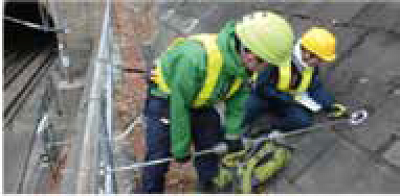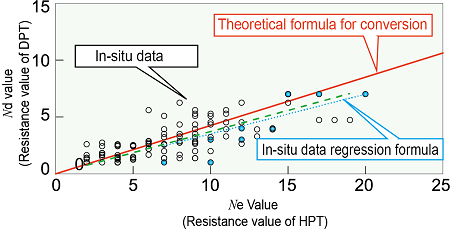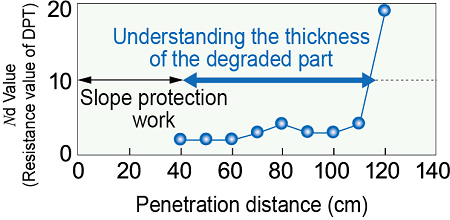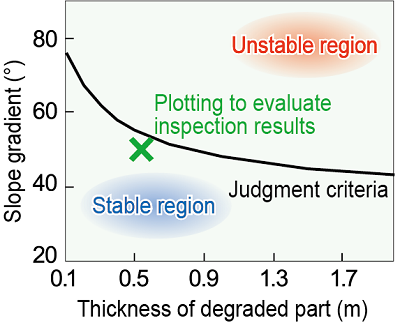12. Low-cost deterioration evaluation method for the backside ground of slope protection works
Since there is a risk of collapse on slopes where the ground of the backside of the slope protection work is deteriorating, it is necessary to maintain the slope protection work according to the degree of deterioration of the backside ground. To address this issue, we have developed a low-cost and easy-to-use horizontal cone penetration test method (Hereinafter referred to as HPT) to evaluate the degree of deterioration of the backside ground and a slope stability evaluation method using a nomogram.
In the HPT, a rod is driven horizontally through existing weep holes in the slope protection work to the backside ground to determine the Ne value (Resistance value of HPT) (Fig. 1). Using the newly proposed conversion formula, this value can be converted to the Nd value of the method for portable dynamic cone penetration test (JGS 1433-2012, Hereinafter referred to as DPT), which is widely used in railways (Fig. 2), and the thickness of the degraded and sedimented part of the ground is determined (Fig. 3). The test can be carried out in about 10 minutes for one point without removing the slope protection work, which is about 1/20th of the cost and 1/30th of the time required for a conventional boring investigation of the backside ground. In addition, by using the newly created nomogram, the stability of the slope protection work can be determined from the test results (Fig. 4).
We have compiled the results of these studies, examples of health judgments to be utilized for visual inspections, and the main points of countermeasure methods to create a maintenance manual for shotcrete slope protection works. This manual also describes the simple elastic wave exploration, which was developed as an inspection method for rock slopes that are not suitable for penetration tests and can be used as a comprehensive maintenance manual.
Other Contents
- 9. Restoration techniques for embankments reusing collapsed soil
- 10. Structural performance evaluation of existing bridges by acceleration monitoring
- 11. Multi-point synchronous measurement system for railway bridge vibration using a video camera
- 12. Low-cost deterioration evaluation method for the backside ground of slope protection works
- 13. Boring method for constructing a crossing structure under railway tracks making it possible to shorten the construction period
- 14. Maintenance method for prestressed concrete sleepers according to the installation environment
- 15. Low-cost ballastless tracks for existing lines and roadbed improvement method
- 16. The image analysis engine for around track to support train patrol
- 17. Insulator contamination estimation method based on public data
- 18. Degradation evaluation method for lithium-ion batteries for vehicle control circuits
- 9. Restoration techniques for embankments reusing collapsed soil
- 10. Structural performance evaluation of existing bridges by acceleration monitoring
- 11. Multi-point synchronous measurement system for railway bridge vibration using a video camera
- 12. Low-cost deterioration evaluation method for the backside ground of slope protection works
- 13. Boring method for constructing a crossing structure under railway tracks making it possible to shorten the construction period
- 14. Maintenance method for prestressed concrete sleepers according to the installation environment
- 15. Low-cost ballastless tracks for existing lines and roadbed improvement method
- 16. The image analysis engine for around track to support train patrol
- 17. Insulator contamination estimation method based on public data
- 18. Degradation evaluation method for lithium-ion batteries for vehicle control circuits




